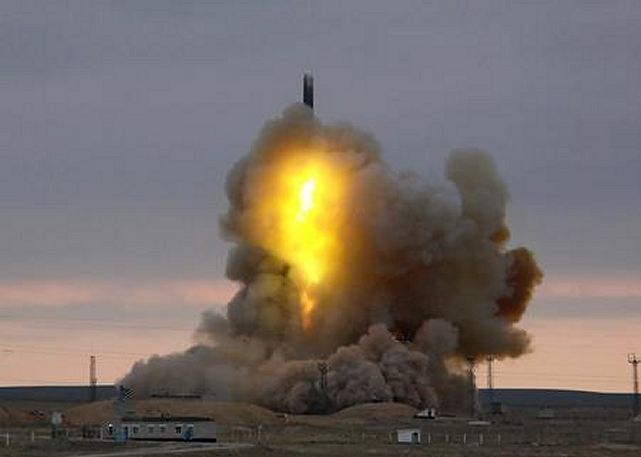Alwaght-Russian Strategic Missile Forces have successfully tested a new hypersonic glide vehicle designed to breach missile defenses and deliver warheads beyond enemy lines, Interfax reported. The test launch was performed Tuesday using an RS-18A strategic ballistic missile (UR-100N, NATO designation SS-19 Stiletto) from a missile deployment area in the Orenburg Region, the source said, adding that the test was a success. Russia’s Defense Ministry has neither denied nor confirmed the report. All modern nuclear warheads are delivered on targets using ballistic trajectory that can be calculated, therefore such warheads could be intercepted. Hypersonic warheads currently in design would be capable of maneuvering by yaw and pitch, eventually becoming impossible to intercept, thus making any existing and upcoming missile defense system impotent. The new warhead is likely to be readied for the upcoming RS-28 Sarmat heavy liquid-propelled ICBM, which is expected to enter testing later this year. Tests of the new Russian ICBM RS-28 Sarmat, which is meant to replace the outgoing heavy silo-based Soviet R-36M missiles, dubbed “Satan” by NATO, are likely to begin in summer this year. China also recently successfully tested a new long-range ballistic missile capable of engaging any potential target worldwide and hitting the United States within just 30 minutes. The Dongfeng-41 is a Chinese nuclear solid-fueled road-mobile intercontinental ballistic missile that can fire six to 10 nuclear multiple independently targetable warheads at a distance of more than 10 thousand kilometers. China newest intercontinental ballistic missile is the world’s longest-range missile. United States imperialism and provocative military maneuvers outside its borders have raised concern globally with other powerful nations modernizing their armaments especially missile defenses to counter Washington's moves.
- In Imam Khomeini’s Discourse, Palestinian Cause Is a Test of Right and Wrong
- Iran’s Supreme Leader Dismisses US Power on Nuclear Policy: ‘They Can’t Stop Us’
- Araghchi’s Beirut Visit Opens New Chapter
- Foreign Ministry: Persian Gulf Trio Islands Are Integral Part of Iran
- Tehran Committed to Continuing Talks, Says Spokeswoman
- Araghchi Reiterates Iran’s Backing for Lebanon in Beirut Visit
- Bloodshed in Gaza Continues as Israeli Strikes Hit Rafah
- Qalibaf: Iran and Cuba Have Mutual Friends and Enemies
- Nuclear Iran: US Fear of Rise of New Power in New Energies Market
- Pulse of Syria Energy in Trump’s Hands
Editor's Choice

In Imam Khomeini’s Discourse, Palestinian Cause Is a Test of Right and Wrong Imam Khomeini of Iran raised the Palestinian cause as a criteria with which we can test who is the true advocate of human rights.
Can South Africa Apartheid Fall Offer Lessons to Check Israel? World unity against Israel can make a dramatic difference, but the Western support to Israeli crimes cannot be underestimated.
Moscow Security Meeting: New Architecture of International Security with Eastern Vision Russia meeting envisions rise of a new security mechanism with an Eastern approach far from abusive Western approaches.
Iran and Pakistan: Convergence in Regional Crises Tehran and Islamabad bear the potential to work for a stronger relationship that contributes to regional peace and stability.
Iran’s Firm Stance in Nuclear Talks Disallows Another Libya Scenario The West should know Iran is not Libya and even heavier pressure cannot bring Iran to its knees.
News

Iran’s Supreme Leader Dismisses US Power on Nuclear Policy: ‘They Can’t Stop Us’
Supreme Leader Ayatollah Seyyed Ali Khamenei has emphasized that uranium enrichment is central to Iran’s nuclear programForeign Ministry: Persian Gulf Trio Islands Are Integral Part of Iran Iran’s Foreign Ministry has rejected the repetitive claims about three Iranian islands in the GCC’s final communiqué
Tehran Committed to Continuing Talks, Says Spokeswoman Iran isn’t withdrawing from negotiations but stands ready for every possibility, the spokesperson declared
Araghchi Reiterates Iran’s Backing for Lebanon in Beirut Visit Iran remains firmly behind Lebanon in confronting Israeli occupation, declared Deputy FM Araghchi
Bloodshed in Gaza Continues as Israeli Strikes Hit Rafah Israeli forces fired upon displaced Palestinians awaiting aid in western Rafah, killing at least 23 and wounding others
Qalibaf: Iran and Cuba Have Mutual Friends and Enemies The Iranian Parliament Speaker praised Cuba as an independent ally, noting that the two countries share common objectives, friends, and adversaries
Any Reckless Move by Israel Will Be Met with A Firm Response The Iranian Foreign Ministry Spokesperson stated on Monday that without a doubt, any reckless move by this regime will provoke a firm response
Amid Gaza Aid Massacres, UN Criticizes Israel’s Use of Food as a Weapon The OHCHR condemned Israel for massacring aid recipients at humanitarian sites in Rafah and the Netzarim corridor in central Gaza
White House Orders US Agencies to Halt New Sanctions on Iran According to a US media outlet, the US paused new sanctions on Iran even as it continues its ’maximum pressure’ campaign
Iranian FM in Cairo Calls on Muslim World to Unite Against Israeli Offensives in Gaza Iran’s top diplomat Abbas Araghchi has appealed to Muslim states for joint and effective steps to confront Israeli atrocities in Gaza
Uranium Enrichment a Non-Negotiable for Iran, Says Nuclear Agency Chief Iran’s nuclear chief has emphasized that uranium enrichment is a vital and uncompromisable component of the country’s nuclear program
Iran Provides Polio Vaccines to Venezuela Despite US Sanctions An Iranian company has delivered an initial batch of polio vaccines to Venezuela as part of expanding cooperation between the two nations
Ukrainian Drone Strikes Across Russia Result in One Fatality At least one person was killed and air travel was disrupted across Russia following Ukraine’s second consecutive day of large-scale drone attacks
Father Of Israeli Hostage Calls on Trump to Pressure Netanyahu to Halt Gaza Offensive The father of an Israeli captive held by Hamas in the Gaza Strip has urged former US President Donald Trump to pressure Prime Minister Benjamin Netanyahu
West Bank Tensions Soar Amid Violent Raids by Israeli Forces and Settlers Israeli forces have escalated their violent raids across multiple areas of the West Bank
Iran Received Parts of A US Proposal Via Oman and Will Respond Based on Its National Interests Foreign Minister Abbas Araghchi confirmed that Iran has received parts of a US proposal, relayed by Oman’s top diplomat
Civilian Lives Lost and Hospitals Shut Down Due to RSF Attacks in Sudan Six fatalities reported in RSF attacks as Sudan faces a deadly cholera epidemic and deepening humanitarian emergency
Barcelona Cuts Off Relations with Israel Amid Gaza Atrocities Barcelona’s city council voted Friday to break institutional relations with the Israeli regime amid the Gaza massacres
Nuclear Energy a Fundamental Right of Iranians, Says Foreign Minister Foreign Minister Abbas Araghchi emphasized that nuclear technology, including uranium enrichment, is an inalienable right of the Iranian people
Israel’s Flagship Warplanes May Soon Be Humiliated by Yemen In response to persistent Israeli aggression, Yemen says it is strengthening its air defenses and promises to humiliate Israel’s most celebrated aircraft
Most Viewed
In Imam Khomeini’s Discourse, Palestinian Cause Is a Test of Right and Wrong
What’s behind Al-Jolani’s Secret Deals with Tel Aviv?
Israel’s Flagship Warplanes May Soon Be Humiliated by Yemen
Why Isn’t There Hope in Istanbul Talks on Ukraine?
Nuclear Iran: US Fear of Rise of New Power in New Energies Market
Bloodshed in Gaza Continues as Israeli Strikes Hit Rafah
Amid Gaza Aid Massacres, UN Criticizes Israel’s Use of Food as a Weapon
Araghchi’s Beirut Visit Opens New Chapter
Father Of Israeli Hostage Calls on Trump to Pressure Netanyahu to Halt Gaza Offensive
Iranian FM in Cairo Calls on Muslim World to Unite Against Israeli Offensives in Gaza
Barcelona Cuts Off Relations with Israel Amid Gaza Atrocities
Any Reckless Move by Israel Will Be Met with A Firm Response
Foreign Ministry: Persian Gulf Trio Islands Are Integral Part of Iran
Iran Provides Polio Vaccines to Venezuela Despite US Sanctions
Pulse of Syria Energy in Trump’s Hands
Araghchi Reiterates Iran’s Backing for Lebanon in Beirut Visit
Failed Mission: Tel Aviv Running into Impasse on Yemen
Hunger for Petrodollars: What to Expect from Trump’s Persian Gulf Tour?
India-Pakistan War Showcased China’s Arms Power against West
Biblical Military Namings in Gaza War and Their Hidden Aims
Iran and Pakistan: Convergence in Regional Crises
Intense Fighting Resumes Between SDF and Syrian Army in Aleppo
Three Hidden Motives for Bin Salman to Mediate Syria Sanctions Relief
Why’s Hezbollah Lead in Municipal Elections Important?
US President Trump Arrives in Saudi Arabia for a $1 Trillion Deal
Journalist Hassan Eslaih Killed in Israeli Attack on Nasser Hospital
Has France Really Become Supporter of Palestine?
Iran and Turkmenistan to Finalize Third Power Transmission Line
Iran and Belarus Explore Strengthening Military Cooperation
Nuclear Riddle in $1 Trillion US-Saudi Deal
Is Trump Mulling Shift in Gaza Strategy?
In Focus

Ansarullah
A Zaidi Shiite movement operating in Yemen. It seeks to establish a democratic government in Yemen.
Shiite
represents the second largest denomination of Islam. Shiites believe Ali (peace be upon him) to be prophet"s successor in the Caliphate.
Resistance
Axis of Resistances refers to countries and movements with common political goal, i.e., resisting against Zionist regime, America and other western powers. Iran, Syria, Hezbollah in Lebanon, and Hamas in Palestine are considered as the Axis of Resistance.
Persian Gulf Cooperation Council
A regional political u n i o n consisting of Arab states of the Persian Gulf, except for Iraq.
Taliban
Taliban is a Sunni fundamentalist movement in Afghanistan. It was founded by Mohammed Omar in 1994.
Wahhabism & Extremism
Wahhabism is an extremist pseudo-Sunni movement, which labels non-Wahhabi Muslims as apostates thus paving the way for their bloodshed.
Kurds
Kurds are an ethnic group in the Middle East, mostly inhabiting a region, which spans adjacent parts of Iran, Iraq, Syria, and Turkey. They are an Iranian people and speak the Kurdish languages, which form a subgroup of the Northwestern Iranian branch of Iranian languages.
NATO
The North Atlantic Treaty Organization is an intergovernmental military alliance based on the North Atlantic Treaty which was signed on 4 April 1949.
Islamic Awakening
Refers to a revival of the Islam throughout the world, that began in 1979 by Iranian Revolution that established an Islamic republic.
Al-Qaeda
A militant Sunni organization founded by Osama bin Laden at some point between 1988 and 1989
New node














